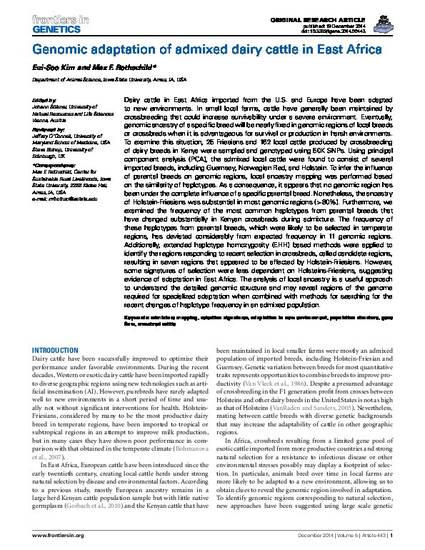
Dairy cattle in East Africa imported from the U.S. and Europe have been adapted to new environments. In small local farms, cattle have generally been maintained by cross breeding that could increase survivability under a severe environment. Eventually, genomic ancestry of a specific breed will be nearly fixed in genomic regions of local breeds or crossbreds when it is advantageous for survival or production in harsh environments. To examine this situation, 25 Friesians and 162 local cattle produced by crossbreeding of dairy breeds in Kenya were sampled and genotyped using 50K SNPs. Using principal componen tanalysis (PCA), the admixed local cattle were found to consist of several imported breeds, including Guernsey, Norwegian Red, and Holstein. To infer the influence of parental breeds on genomic regions, local ancestry mapping was performed based on the similarity of haplotypes. As a consequence, it appears that no genomic region has been under the complete influence of a specific parental breed. Nonetheless,the ancestry of Holstein-Friesians was substantial in most genomic regions (>80%). Furthermore, we examined the frequency of the most common haplotypes from parental breeds that have changed substantially in Kenyan crossbreds during admixture. The frequency of these haplotypes from parental breeds, which were likely to be selected in temperate regions, has deviated considerably from expected frequency in 11 genomic regions.Additionally, extended haplotype homozygosity (EHH) based methods were applied to identify the regions responding to recent selectionin crossbreds, called candidate regions, resulting in seven regions that appeared to be affected by Holstein-Friesians. However, some signatures of selection were less dependent on Holsteins-Friesians, suggesting evidence of adaptation in East Africa. Thean alysis of local ancestry is a useful approach to understand the detailed genomic structure and may reveal regions of the genome required for specialized adaptation when combined with methods for searching for the recent changes of haplotype frequency in an admixed population.
Available at: http://works.bepress.com/max-rothschild/59/

This is an article from Frontiers in Genetics 5 (2014): 1, doi:10.3389/fgene.2014.00443. Posted with permission.